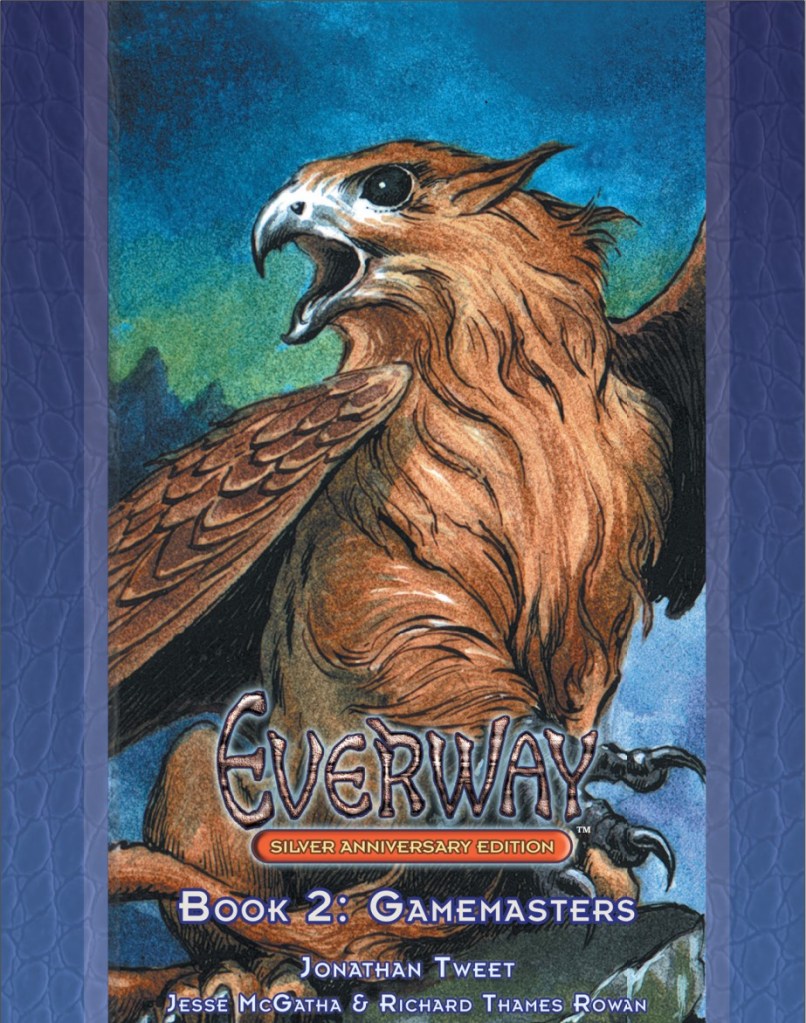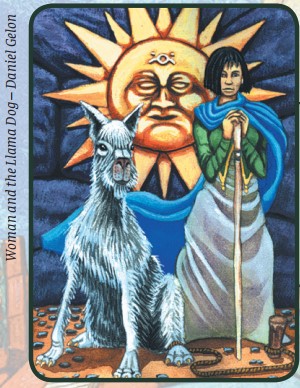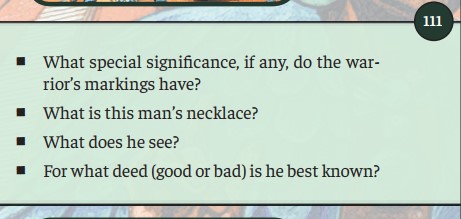

One of the things that we’ve spent a lot of time on at Angel’s Citadel since we’ve started writing blog posts and reviews is trying to find, understand, review, and sometimes incorporate various roleplaying mechanics into our own thinking and designs. From fairly traditional backgrounds in Dungeons & Dragons and Shadowrun, we’ve encountered quite a few new (to us) systems and thought processes that have changed how we look at Tabletop Roleplaying Games. Systems like FATE, Forged in the Dark, Powered by the Apocalypse, Genisys, Ironsworn, and others, have forced us out of the mindset that there was only one (or a small handful of) way(s) to present roleplaying information. In our minds, this is a very good thing.
This week, we cover another system that has done this for me anyway (and will likely do so for Joann when she gets time to read it). That system is a re-release of one that I had never heard of growing up, but released its first edition in 1995. The game is Everway, now owned by the Everway Company, which released a silver anniversary edition after a successful Kickstarter earlier this year. Originally written by Jonathan Tweet whose credits also include the 3rd Edition of Dungeons & Dragons, Ars Magica from Atlas Games, and 13th Age from Pelgrane Press among others, at the time Everway was released, the concept for the game was revolutionary. There are no dice involved (we’ll talk about what actually does drive the game in a minute). It was profoundly more narrative than any other game of its time. When I first saw the Kickstarter, I knew I had to get it if only just to understand how the game worked. So let’s dive in, shall we?
Manufacturing & Production
The Silver Anniversary Edition of Everway is a two-book set. A Player’s Handbook and a Gamemaster’s Guide. The books themselves are a faithful reproduction of the content of the original books with some additional clarification to portions of the system. So as one looks through, the artwork is dated, and while you may not like the art style, it was fairly typical of the time. The PDF’s are quite well laid out with bookmarks and internal hyperlinks to help the reader find specific things and the entire index is linked (something I often don’t see). What really impressed me, however, was the physical production.
The books are solid, with heavy covers and good quality pages and inks. The silver foil on the page edges adds a very elegant feel to the Anniversary Edition. The binding seems tight and like it will stand up very well to life on my gaming shelves with all the other good little games except for the two editions of what used to be our favorite game that are falling apart like utter garbage. The other place where this product shines is the Deluxe Tarot Deck. These cards are thick, bronze foil edged, and feel very premium. The quality is impeccable and the layout only slightly detracts from the art due to the interpretive text on the short edges of the card. All in all, while I did not get everything that I could have bought, what I did get is a phenomenally quality product.
Content
Everway is a game where the players create characters that are Spherewalkers. Think of Spheres as different worlds or different planes of existence even. The central Sphere in the game is the Sphere of Fourcorner. On this Sphere one finds the realm of Roundwander where you can journey to the city of Everway. From Roundwander and Everway, a Spherewalker’s journey can take them to many other Spheres, which are home to as many or more different kinds of civilizations.
“EVERWAY presents a world of warriors, shamans, monks, assassins, unicorns, dragons, goblins, ghosts, temples, castles, shrines, ruins, curses, spells, prayers, and quests. The heroes of EVERWAY games travel from realm to realm. Some of these lands have knights, castles, dragons, and wizards, similar to the settings in many popular fantasy stories and games. Other realms, however, more closely match historical places and eras, such as indigenous North America, ancient Middle Eastern lands, imperial China, feudal Japan, tribal northern Europe, ancient India, the Aztec empire, African kingdoms, and so on. Still other realms contain people and cultures unlike anything that’s ever existed on earth, including lands populated by societies that aren’t human. The people, lands, creatures, and adventures found in a game of EVERWAY are limited only by the imaginations of those playing.”
Everway, Book 1 – Players, p. 14
The concept of the game makes me feel like it could very easily have been inspired by Rifts, by Kevin Siembieda, which came out in 1990, or have been an inspiration for the recursions of the Strange by Bruce Cordell, which came out in 2014.
The game itself is driven by a few numbers, no dice, and three rules. The first is the Law of Karma: “A hero’s Elements, Specialties, Powers, Magic, and tactics determine the outcome of their action”. In other words, the few numbers compare to NPC numbers or “difficulties” and logic prevails. The second rule is the Law of Drama: “The needs of the plot determine the outcome of a hero’s action”. In other words, the Gamemaster and players telling a good story shows what will happen in a given situation. The third rule is the Law of Fortune: “A draw from the Fortune Deck determines the outcome of a hero’s action”. The Fortune Deck is a 36-card deck that represents what those familiar with the Tarot would consider the Major Arcana. If you have a Delux Tarot Deck, there are an additional 41 cards called the Seasons Deck that represent the Minor Arcana of the Tarot. Book 2 – Gamemaster, pages 15 – 28 gives quite a bit of detail about these three rules and when and how to use them to help facilitate story and action. The system is set up so that all three can inform a given event – there is no priority given to any of them. In other words, they are simply three tools in a GM’s toolbox.

In Book 1 – Players, the first portion discusses the setting, answers several questions about the game itself and the design intent, and then covers how to build characters to play as. Following that is a section on the Fortune Deck with information on the cards themselves and some broad interpretive meanings of both their standard and reversed states. Behind that, is a section on the vision cards (the decks that I did not purchase because they are all included as pictures in Book 1) with inspirational art and prompting questions used in character creation to help flesh out the character’s background and how the character became what they are, world creation to build additional Spheres and locations/realms within them, and quest creation to give the PCs challenges to face. Finally, there is a section with some quick-start rules to help new players get quickly into the action as well as some pre-generated characters that can be used immediately. There are also some pages that can be copied and handed out as a quick reference to common rules and things that players and GMs alike would need to know.


In Book 2 – Gamemasters, the first section gives loads of advice, particularly for Gamemasters new to the game, on how to run Everway, adjudicate actions, and deal with things like combat and wounds and such with the low-complexity mechanics. Each of these situations is related back to the three rules mentioned previously with examples and explanations of the thought process of using each as it applies to that situation. The second chapter in this section gives advice for running an Everway session. This is something of a unique section among GM sections in rulebooks that I’ve seen in that it makes use of a lot of questions and something like follow-along instructions to teach GMs what to do in different situations using adjudication and Fortune deck pulls.
The third chapter in this section deals with building quests and realms in Everway using the Fortune deck. With example quests and realms and lots of advice on how to make them both vibrant and flavorful as part of the larger setting. The fourth chapter in the section deals with creatures, adversaries, and challenges that the characters will face. Each of these has a set of element abilities already filled out for you to use as a stat block and they are broken down into several categories.
The second section gives four, fully-detailed quests for Gamemasters to use, along with a recommendation for the first one to play, an updated version of the original ready-to-run quest by Jonathan Tweet, Journey to Stonedeep. There are two other quests that have been updated, Thief of Storms and the Bright Fires, and a new one released with the Silver Anniversary Edition, the Soul of Winter. The endpapers in this book also contain useful information for the GMs reference.
Critique
Having not yet played the game, I don’t have much in the way of critique. The only thing that I might consider it, and even then, I hesitate, would have to do with the Deluxe Fortune deck. The core Everway book that contains the Fortune deck images along with recommended interpretations is Book 1. But it only contains the original 36 cards. With the re-release, I believe there is a plan to release a PDF containing the interpretations for the full deck (if I understand the Kickstarter rewards right), but personally, I would have included them as extra pages in section 2. Currently, the only help is in the form of several “instruction” cards included with the deck which, while helpful, are somewhat unwieldy to use at the table in my opinion.
I understand not every player would have gotten the Deluxe Fortune deck. But in my mind this would have done two things. The extra cards would have promoted purchasing it after the fact for those that didn’t, and it makes it so that those playing the game have fewer sources they need to keep open (particularly if they are using the print books because the key is not supposed to come in print – only PDF) at their table. It’s a nitpicky thing, I know, but it is my only current criticism of the game.
Summary
Everway, the Silver Anniversary Edition is a reprint of the 1995 first edition of the game. The Kickstarter product is an extremely high-quality production that feels durable and worth the money paid. As far as the game goes, this one very much strikes the right notes with me, being much more on the narrative side of gaming, with the game being an ongoing conversation between the GM and the players. The use of the Tarot deck, particularly with the expansion of the Seasons deck gives 144 possibilities of single-card draws and for realm creation, with the simple three-card Virtue-Fault-Fate, you get an absurdly large number of possibilities (enough that when compared to potential playtime, one might consider it “endless”).
I will say that I am personally excited to play this game and perhaps run it at some point. While there are certain similarities to the Oracle of Ironsworn that I have already used, the feel of this is quite different in both the use of the Tarot deck and the vision cards. Everway, in my opinion, was very much a system ahead of its time. With so many independent publishers now moving into the more unique or specialized game mechanics as their design choices, it seems like this would fit better in today’s market landscape. Perhaps, then, it is a good thing that the choice to re-release it was made. Perhaps now is, indeed, the time to travel to Everway and begin one’s journey as a Spherewalker. Happy gaming!
- Josh Walles
